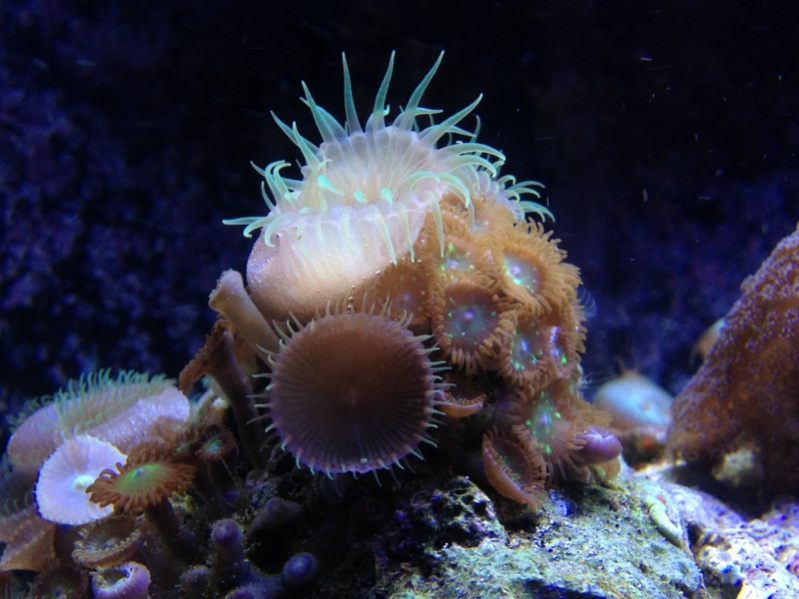I was so excited that I could barely sleep. I stood outside in the frigid weather for 20 minutes before the store opened. I chose wisely, asked a lot of questions, and parroted the responses to my girlfriend multiple times.
I brought them immediately to the tank and, using a drip acclimation method, I acclimated my purchases to my tanks conditions. To drip acclimate, one must slowly drip water from a hose to the livestock's temporary container. The rate should allow for the volume to triple in 45 minutes. My mom and stepdad were lucky enough to be here to witness the move to the new home.
I'm sure you are wondering, "What did you get?". Well here is my starting lineup:
Amphiprion ocellaris
Care level: Easy
Diet: Omnivore
Origin: Fiji/Tonga
Temperament: Peaceful
Max Size: 3
½”
Notes: Should
be kept either singularly, or in pairs – only if started before sexual
maturity. Clownfish are sequential hermaphrodites – starting as males and then
maturing into females. When a hierarchy is established, the most dominant fish
becomes the female. Once decidedly female the fish cannot become male again.
Clownfish in the wild have a symbiotic relationship with anemones. The same
relationship is possible within the reef aquarium environment.
 |
| Eli and Peyton Swimming Across the Tank |
Lysmata amboinensis
Care level: Easy
Diet: Carnivore
Origin: Sri
Lanka
Temperament: Peaceful
Max Size: 2”
 Notes: These
creatures choose a location in the tank and set up “shop”. They are tank
scavengers, but also have a beneficial relationship with fish in the aquarium.
In this relationship the Skunk Shrimp will clean dead scales and parasites from
the entire fish (including the inside of the mouth.)
Notes: These
creatures choose a location in the tank and set up “shop”. They are tank
scavengers, but also have a beneficial relationship with fish in the aquarium.
In this relationship the Skunk Shrimp will clean dead scales and parasites from
the entire fish (including the inside of the mouth.) |
| Pierre Garçon Hanging Upside-down in his "shop" |
Super Tonga
Nassarius Snail (4):
Nassarius distortus
Care level: Easy
Diet: Carnivore/Omnivore
Origin: Tonga
Temperament: Peaceful
Max Size: 1”
Notes: These
snails spend a lot of time buried in the sand. They use a siphon tube to
breathe when the are buried. Their diet consists of shifting through the
sand looking for detritus. This also helps in oxygenation of the sand bed. Some
aquarium keepers liken them to zombies rising from the grave.
Astraea Turbo
Snail (4):
Astraea tecta
Care level: Easy
Diet: Herbivore
Origin: Caribbean
Temperament: Peaceful
Max Size: 1”
Notes: These
snails eat nuisance algae, including the difficult to control hair algae. If
knocked over this snail has a difficult time righting itself, and can drown
without intervention to be up-righted.
Turbo fluctuosa
Care level: Easy
Diet: Herbivore
Origin: Mexico
Temperament: Peaceful
Max Size: 2”
Notes: Prefer
large areas for grazing and lots of places to hide. They require calcium from
the water to build their shells. Aquarium owners complain that they knock over
rocks and coral due to their large size.
Actinodiscus
malaccensis
Care level: Easy/Moderate
Diet: Carnivore
Origin: Dutch
East Indies
Temperament: Semi-aggressive
Notes: The
coral obtains its nutrition from symbiotic algae, zooxanthellae,
that dwells within their tissues. They can be a aggressive and attack other
corals in vicinity with toxins.
 |
| Neon Green Under the Moonlight |
Actinodiscus
cardinalis
Care level: Easy/Moderate
Diet: Carnivore
Origin: Dutch
East Indies
Temperament: Semi-aggressive
Notes: The
coral obtains its nutrition from symbiotic algae,
zooxanthellae, that dwells within their tissues. They can be a aggressive and
attack other corals in vicinity with toxins.
 |
| Nighttime at the Club! |
My girlfriend suggested naming all of the fish after quarterbacks, and the supporting cast after utility players. We decided to name the Brittle Star Polamalu - currently looking for suggestions for the Serpent Star. Leave a name in the comments - who knows maybe you will be the one who gets to name him!
The tank is doing well - still stable after a few days. The original occupants are doing fine as well. This is an image of one of the Blue Leg Hermit switching homes. Thanks for noticing Mom!
 |
| Tried it on for fit, and decided to move in. |


















































